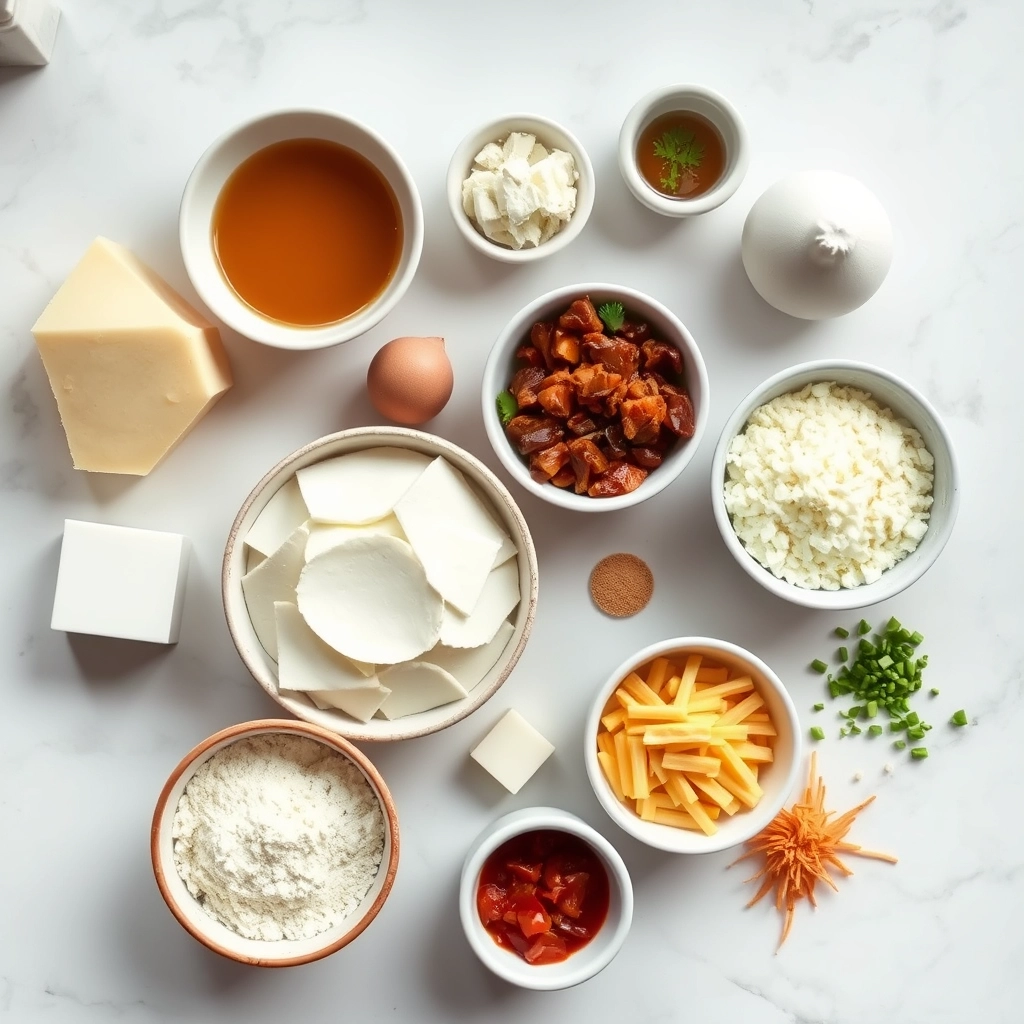Introduction
Hi there! I’m Emily, the heart and soul behind brekcakes.com. From my earliest memories, the kitchen has always been a place of warmth and creativity. It’s where I discovered the magic of turning simple ingredients into extraordinary meals and learned that the best dishes are often made with love as the main ingredient.
There’s something undeniably comforting about a classic Quiche Lorraine. Whether you’re hosting a brunch or simply craving a savory slice, this dish brings people together with its rich flavors and buttery crust. Moreover, it’s versatile enough to suit any occasion, from lazy Sunday mornings to elegant dinner parties. If you’ve ever wondered how to master this French staple, you’re in the right place. After all, nothing beats the aroma of caramelized onions, crispy bacon, and creamy custard baking to golden perfection.
Quiche Lorraine is more than just a tart—it’s a celebration of simplicity and tradition. Originating from the Lorraine region of France, this dish combines a flaky pastry crust with a velvety egg filling, smoky bacon, and nutty Gruyère cheese. What makes it special? First, it’s incredibly adaptable. You can serve it warm or at room temperature, making it perfect for meal prep or last-minute guests. Second, it embodies the cozy, approachable vibe of brekcakes.com, where every recipe feels like a hug on a plate. If you love rustic, soul-satisfying food, you’ll adore our savory pie collection, which features more hearty favorites. And if you’re new to baking, don’t worry—our beginner’s guide will help you build confidence in the kitchen.
Why I Love This Recipe
Quiche Lorraine holds a special place in my heart because it reminds me of my grandmother’s kitchen. She taught me that cooking isn’t just about following steps—it’s about pouring your heart into every layer. Every time I bake this quiche, I remember her hands guiding mine as we rolled out the dough and her laughter filling the room. Now, I get to share that same joy with you. Whether you’re a seasoned cook or a beginner, this recipe promises to deliver not just a delicious meal but also a moment of connection—one slice at a time.
Health and Nutrition
Why it’s good for your body
Quiche Lorraine packs a nutritious punch while delighting your taste buds. First, eggs provide high-quality protein and essential amino acids, which help build muscle and keep you full longer. Additionally, the dish includes cheese and cream, offering calcium for strong bones and healthy teeth. Though rich, Quiche Lorraine balances these ingredients with a flaky crust that adds satisfying texture.
Moreover, Quiche Lorraine often features bacon or ham, which contributes iron and B vitamins for energy. If you opt for a homemade version, you can control the sodium and fat levels for a healthier twist. Furthermore, the eggs in Quiche Lorraine contain choline, a nutrient that supports brain function and metabolism. Even better, you can easily add spinach or mushrooms to boost fiber and antioxidants.
Finally, Quiche Lorraine serves as a versatile meal that fits any time of day. Whether you enjoy it for breakfast, lunch, or dinner, it delivers steady energy without spiking blood sugar. With its combination of protein, fats, and carbs, Quiche Lorraine keeps you satisfied and nourished.
How it fits in a healthy lifestyle
Quiche Lorraine adapts effortlessly to balanced eating habits. For a lighter version, swap heavy cream for Greek yogurt or use a gluten-free crust to accommodate dietary needs. Pair it with a fresh salad or roasted vegetables to round out your meal with extra nutrients. If you’re watching your protein intake, Quiche Lorraine already delivers a solid amount per slice.
For those focused on heart health, choose leaner meats like turkey bacon or load up on veggies. You can even explore our guide to healthy breakfast ideas for more inspiration. Meanwhile, meal preppers will love how well Quiche Lorraine stores and reheats. Check out our tips for meal prepping like a pro to make the most of this dish throughout the week. With smart tweaks, Quiche Lorraine fits seamlessly into any wellness plan.
PrintQuiche Lorraine
Description
A classic French tart with a savory custard filling, bacon, and cheese.
Ingredients
For the Crust:
- 1 pre-made pie crust
- 6 slices bacon, cooked and crumbled
- 1 cup shredded Gruyere cheese
- 4 large eggs
- 1 cup heavy cream
- 1/2 teaspoon salt
- 1/4 teaspoon black pepper
- 1/4 teaspoon nutmeg
Instructions
1. Prepare the Crust:
- Preheat oven to 375°F (190°C).
- Place the pie crust in a 9-inch pie dish and crimp the edges.
- Sprinkle bacon and cheese evenly over the crust.
- In a bowl, whisk together eggs, cream, salt, pepper, and nutmeg.
- Pour the egg mixture over the bacon and cheese.
- Bake for 30-35 minutes or until the center is set and the top is golden.
- Let cool for 10 minutes before slicing.
Notes
You can customize the seasonings to taste.

How to Prepare This Dish
Steps and time-saving tips
Start by preheating your oven to 375°F so it’s ready when your Quiche Lorraine filling is prepared. While it heats, roll out your pie crust and press it gently into a 9-inch tart pan, trimming any excess edges. For a crispier crust, blind bake it for 10 minutes with parchment paper and pie weights—this prevents sogginess later. Meanwhile, cook diced bacon in a skillet until crispy, then drain it on paper towels to remove excess grease. In the same pan, sauté thinly sliced onions until caramelized for extra depth of flavor. In a large bowl, whisk together eggs, heavy cream, salt, pepper, and a pinch of nutmeg until smooth. Sprinkle the bacon and onions evenly over the pre-baked crust, then pour the egg mixture over them. Top with shredded Gruyère cheese for that classic Quiche Lorraine richness. Bake for 30-35 minutes until the center is set and the top turns golden. Let it cool slightly before slicing. To save time, prep the crust and filling ingredients the night before, then assemble and bake the next day.
Mistakes I’ve made and learned from
I once rushed the blind-baking step and ended up with a soggy Quiche Lorraine crust—lesson learned! Now I always bake the crust until lightly golden before adding the filling. Another mistake? Overloading the quiche with too much cheese, which made it dense instead of light and fluffy. I’ve since found the perfect balance by following tips from my guide to perfect pie crusts and using Gruyère sparingly. If your filling spills while transferring the quiche to the oven, try placing the pan on a baking sheet first—it’s a game-changer. For more troubleshooting, check out my common baking mistakes post to avoid pitfalls I’ve faced. Trust me, a little patience goes a long way with this dish!

Cultural Connection and Variations
Where this recipe comes from
Quiche Lorraine whispers stories of rustic French kitchens and bustling village markets. Born in the Lorraine region of France, this savory tart originally featured just eggs, cream, and smoky bacon—no cheese, unlike many modern versions. Farmers and bakers crafted it as a hearty meal to fuel long days, and over time, it became a symbol of French comfort food. Today, you’ll find Quiche Lorraine gracing brunch tables worldwide, but each culture adds its own twist. In Germany, they might swap lardons for speck, while in the U.S., cheddar often joins the party. My grandma, for instance, sneaks caramelized onions into hers, claiming it “softens the richness.” Whether you stick to tradition or play with flavors, Quiche Lorraine always feels like a warm hug from history.
How it fits in today’s cooking
Quiche Lorraine isn’t just a relic—it’s a chameleon. Busy parents love it for make-ahead lunches, and food bloggers rave about its versatility. (Try pairing it with a crisp spring salad for a light yet satisfying meal.) Modern cooks also tweak the classic with gluten-free crusts or plant-based bacon, proving it adapts to any diet. During holidays, it’s a star at Easter brunches or Christmas mornings, bridging generations over flaky crusts and creamy fillings. And let’s be honest: few dishes balance elegance and ease like Quiche Lorraine. For more inspiration, check out these brunch ideas to see how it shines alongside other favorites. From rustic roots to today’s tables, it’s a dish that never goes out of style.
Taste and Texture
What makes it delicious
Quiche Lorraine delivers a rich, savory experience that melts in your mouth. The buttery, flaky crust crumbles with each bite, while the creamy custard filling wraps around smoky bacon and nutty Gruyère cheese. Every forkful offers a perfect balance—silky eggs, crispy edges, and a hint of caramelized onion sweetness. The aroma alone, fragrant with toasted pastry and savory pork, will make your kitchen smell irresistible. Quiche Lorraine shines because of its contrast: tender custard meets crisp crust, and salty bacon plays off the mild, earthy cheese. It’s comfort food at its finest.
Boosting the flavor
For an even bolder Quiche Lorraine, try swapping Gruyère for sharp cheddar or adding a pinch of smoked paprika to the custard. A drizzle of hollandaise sauce adds luxurious richness, while caramelized onions deepen the savory notes. If you love herbs, stir fresh thyme or chives into the egg mixture for a bright, aromatic twist. Serve slices with a side of peppery arugula salad to cut through the richness. Small tweaks can elevate this classic dish without overpowering its timeless appeal.

Tips for Success
Best practices for results
Always chill your dough before rolling it out to prevent shrinking during baking. For the best Quiche Lorraine, pre-bake the crust until lightly golden to avoid a soggy bottom. Use full-fat cream and fresh eggs for a rich, custardy texture. Additionally, cook your bacon until crisp but not burnt to maintain balanced flavor. Finally, let the quiche rest for 10 minutes before slicing to ensure clean cuts.
Mistakes to avoid
Overfilling the crust can cause spills and uneven baking, so leave a quarter-inch border. If your custard cracks, you likely overbaked it—check our perfect custard guide for timing tips. Another common issue is skipping the blind bake step, which leads to a limp crust. For more crust troubleshooting, explore our pie crust secrets. Remember, Quiche Lorraine should jiggle slightly when removed from the oven, as it sets while cooling.
Serving and Pairing Suggestions
How to serve this dish
Quiche Lorraine shines as a versatile centerpiece for any occasion. For a brunch spread, slice it into elegant wedges and arrange them on a rustic wooden board with fresh herbs like chives or parsley for a pop of color. Meanwhile, during holidays, serve individual mini quiches in decorative muffin tins for a charming touch. To elevate the presentation, pair your Quiche Lorraine with a simple side salad or fresh fruit, creating a balanced and visually appealing plate.
What goes well with it
A crisp green salad with a tangy vinaigrette perfectly cuts through the richness of Quiche Lorraine, making it a refreshing companion. Alternatively, try serving it with a warm bowl of roasted tomato soup for a comforting meal. For drinks, a chilled glass of sparkling wine or a citrusy mimosa enhances the flavors beautifully. If you’re looking for more brunch inspiration, check out our fluffy pancake recipe or explore this guide to crafting the perfect breakfast smoothie to round out your menu.

Quiche Lorraine originated in the Lorraine region of France and dates back to the 16th century. Traditionally, it was made with eggs, cream, and smoked bacon or lardons. Over time, cheese was added, though purists argue authentic Quiche Lorraine shouldn’t include it.
Yes, you can substitute whole milk or half-and-half for cream in Quiche Lorraine, though the texture will be slightly less rich. For a dairy-free version, try unsweetened almond or oat milk blended with a tablespoon of cornstarch to thicken the custard.
Quiche Lorraine specifically contains bacon or lardons and no cheese (in its traditional form), while other quiches may include vegetables, seafood, or various cheeses. The classic Quiche Lorraine also uses a simple custard of eggs and cream without additional flavorings.
Blind bake your crust for 10-15 minutes before adding the Quiche Lorraine filling to create a moisture barrier. You can also brush the pre-baked crust with beaten egg white to seal it. Always let the quiche cool slightly before slicing to help the custard set.

